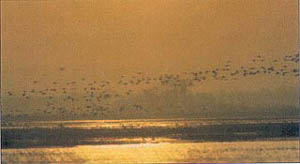Neosho Wildlife Area, KS
Located on the broad, flat flood plain below the junction of Flat Rock Creek and the Neosho River, the wildlife area is a man-made marsh developed by the Department in 1960.
To get to the wildlife area from St. Paul travel east on Highway 47 2 miles to Wallace Rd.; turn south and travel approximately 1.25 miles. Office on west side of road
The area covers 3,246 acres.
The five largest pools on the area represent 1,675 acres of the 1,787 of intensively managed wetlands. There are sixteen independently managed wetlands throughout the area. The area was primarily designed, and is managed to furnish a resting and feeding place for migratory waterfowl.
Three of the sixteen pools are managed in a moist soil environment through a water level manipulation plan. Four green tree marshes ranging in size from five to fifteen acres offer a different type of hunting opportunity for the sportsman using the area. Area personnel plant an average of 400 acres of corn, milo, buckwheat or millet in the hunting pools. The grain is left in the field and inundated in the fall.
The 800-acre refuge pool is closed to all hunting, foot and vehicle traffic during the waterfowl season. The water level of this pool fluctuates naturally throughout the seasons and provides good aquatic habitat for waterfowl. Fishing is allowed from March 31 until August 31. Good fishing can be found at times in the Neosho River, Flat Rock Creek and Brogan Creek, existing in part on the wildlife area.
• Vehicles are permitted on maintained roads only. • Primitive camping is permitted, but please take your trash with you. • Consult area information signs for additional rules and regulations on the area. • Non-toxic shot for all hunting.
For fees and Special Regulations: www.kdwp.state.ks.us/news/KDWPT-Info/Locations/Wildlife-Areas/Region-5/Neosho
